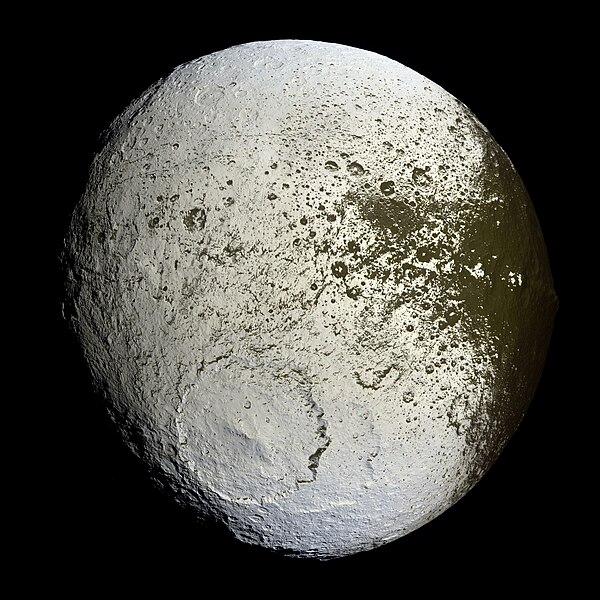|
تضامنًا مع حق الشعب الفلسطيني |
ملف:Iapetus as seen by the Cassini probe - 20071008.jpg

الملف الأصلي (4٬032 × 4٬032 بكسل حجم الملف: 6٫22 ميجابايت، نوع MIME: image/jpeg)
| هذا ملف من ويكيميديا كومنز. معلومات من صفحة وصفه مبينة في الأسفل. كومنز مستودع ملفات ميديا ذو رخصة حرة. |
|

|
اختيرت هذه الصُّورة لتكون صورة اليوم في ويكيميديا كُومِنز بتاريخ 27 December 2007. كان التَّعليق المُرفَق معها كما يأتي: بلغاتٍ أُخرى:
Magyar: A Iapetus, a Szaturnusz egyik holdja, a Cassini űrszonda felvételén hamis színezéssel (NASA/JPL/Space Science Institute) |

|
This image was selected as picture of the day on Vietnamese Wikipedia.
|
ملخص
| الوصفIapetus as seen by the Cassini probe - 20071008.jpg |
Iapetus as seen by the Cassini probe. |
| التاريخ | |
| المصدر | PIA08384: The Other Side of Iapetus |
| المؤلف | NASA / JPL / Space Science Institute |
| الترخيص (إعادة استخدام هذا الملف) |
PD |
فُهرِست هذه الصُّورة أَو هذا التَّسجيل المرئي لدى Jet Propulsion Laboratory التَّابعة لوكالة الفضاء الأَمريكيَّة (ناسا) تحت المُعرِّف PIA08384. لا يُشير هذه الوَسم إلى حالة حقوق التَّأليف والنَّشر الخاصَّة بالعمل المُرفَق؛ لا يزال وَسم حقوق التَّأليف والنَّشر مَطلُوباً، راجع كومنز:ترخيص لمزيدٍ من المعلومات. لغات أخرى:
العربية ∙ беларуская (тарашкевіца) ∙ български ∙ català ∙ čeština ∙ dansk ∙ Deutsch ∙ English ∙ español ∙ فارسی ∙ français ∙ galego ∙ magyar ∙ հայերեն ∙ Bahasa Indonesia ∙ italiano ∙ 日本語 ∙ македонски ∙ മലയാളം ∙ Nederlands ∙ polski ∙ português ∙ русский ∙ sicilianu ∙ slovenščina ∙ Türkçe ∙ українська ∙ 简体中文 ∙ 繁體中文 ∙ +/− |
ترخيص
| Public domainPublic domainfalsefalse |
| يقع هذا العمل في النِّطاق العامّ في الولايات المُتحدة الأمريكيَّة لأَنَّه عملٌ خالِصٌ من إِنتاج وكالة الفضاء الأمريكيَّة. تنصُ حقوق التَّأليف والنَّشر الخاصَّة بوكالة الفضاء الأمريكيَّة على أنَّ "أعمال الوكالة غير مَحميَّة بحقوق التَّأليف والنَّشر ما لم يُذكر خلافُ ذلك". لمزيدٍ من المعلومات انظر القالِب {{PD-USGov}} وصفحة حقوق التَّأليف والنَّشر الخاصَّة بالوكالة وصفحة سياسة الصُّور الخاصَّة بمُختبر الدَّفع النَّفَّاث. |  | |
 |
تنبيهات:
|
الشروحات
٨ أكتوبر 2007
image/jpeg
تاريخ الملف
اضغط على زمن/تاريخ لرؤية الملف كما بدا في هذا الزمن.
| زمن/تاريخ | صورة مصغرة | الأبعاد | مستخدم | تعليق | |
|---|---|---|---|---|---|
| حالي | 22:07، 12 ديسمبر 2018 |  | 4٬032 × 4٬032 (6٫22 ميجابايت) | commonswiki>Kesäperuna | 100% JPEG quality from full quality TIFF, slightly cropped to be more centered. |
استخدام الملف
ال1 ملف التالي مكررات لهذا الملف (المزيد من التفاصيل):
- ملف:Iapetus as seen by the Cassini probe - 20071008.jpg من ويكيميديا كومنز
ال9 صفحات التالية تستخدم هذا الملف:
